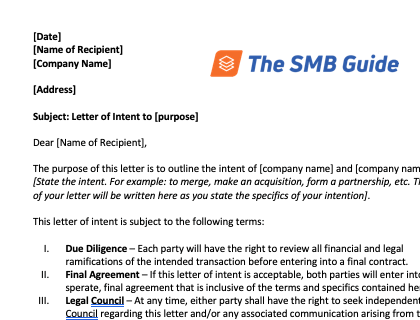Letter of Intent
Learn what's included in a letter of intent, and download a free LOI template. Includes frequently asked questions.
Updated on October 4th, 2023
The SMB Guide is reader-supported. When you buy through links on our site, we may earn an affiliate commission. Learn more
A letter of intent (LOI) is a business document that records the intent of one party to make a purchase from another party. This may involve the purchase of assets, the acquisition of another company, or some other significant deal. The letter outlines a timeline for the deal, and may or may not be legally binding depending on what the parties agree to.
Letter of Intent Template - Free Download
Use our free letter of intent template to create your own customized document.
How to Write a Letter of Intent:
1. State your purpose.
In the opening paragraph, state the purpose of your letter of intent. Essentially, this paragraph will summarize what transaction is being agreed upon, what parties are involved, and what the timeline is.
2. Include details about the negotiations.
If there are any special terms or conditions that either party must agree to, you can include these in your letter of intent.
3. Specify a deadline.
If the letter of intent comes with a deadline for the other party to respond or for the deal to be finalized, state this in writing. If the deal has multiple steps, you may want to include a timeline with the key dates.
4. State if the agreement is non-binding.
In some cases, if a letter of intent is signed by the receiving party, the court may rule that the letter is a legally binding document. If you do not want this to be the case, state explicitly in your letter that it is non-binding. This will help to provide clarity should any legal issues regarding the letter arise later on.
5. Leave contact information.
At the end of your letter of intent, leave your name, title, and contact information, such as a mailing address, phone number, or email address. This makes it easier for the recipient to get in touch with you if they have any questions, and it tells them who in your organization is responsible for the contents of the letter.
Related Articles:
FAQs:
What is the purpose of a letter of intent?
In business, the purpose of a letter of intent is to formally acknowledge the intent of two parties to do business with each other. This may involve the purchase of the real estate, a merger between two companies, or an acquisition.
How do I write a letter of intent?
Start by explaining the purpose of the letter and describing the intent of each party. At the beginning of the letter, you can address the appropriate person by name, whether it is the CEO, a Business Developer, a Salesperson, or the VP of a company.
What does a letter of intent mean legally?
Most of the time, a letter of intent is not legally binding. However, if the letter does not explicitly state that it is non-binding, the ruling could go either way if it were brought before a court. In some cases, it would be dismissed as nothing more than an expression of intent, but if the document is unclear you run the risk of being legally bound.
How enforceable is a letter of intent?
It depends on how the letter is worded. Obviously, if the letter clearly states that it is non-binding, then it is not enforceable. If the document is ambiguous, then it may be enforceable in some cases.
Is a letter of intent necessary?
Business-to-business transactions can be complicated and take a long period of time to unfold. A letter of intent can help both sides to clarify their roles and analyze the potential deal in order to make the best possible decision before anything is finalized. An LOI is not necessarily required, but it may be useful.
What goes into a letter of intent?
- Details about the potential deal/transaction.
- Terms of negotiations.
- Contact information.
- Legal disclaimers and special requests.
Can you change your mind after a letter of intent?
As long as the LOI is noted to be "non-binding", you can still change your mind and walk away from the deal. However, this may not be an option if the document is upheld as legally binding in a court of law.
How long is a letter of intent good for?
This is up to the person/business drafting the letter. Often, LOIs are written with the stipulation that the recipient must respond within a certain timeframe, such as 24 or 72 hours.
What is the difference between a letter of intent and an offer letter?
As their names imply, a letter of intent is simply a statement of intentions, while an offer letter outlines a formal offer between one party and another. Offers can be accepted or declined and initiate a relationship between the parties.

